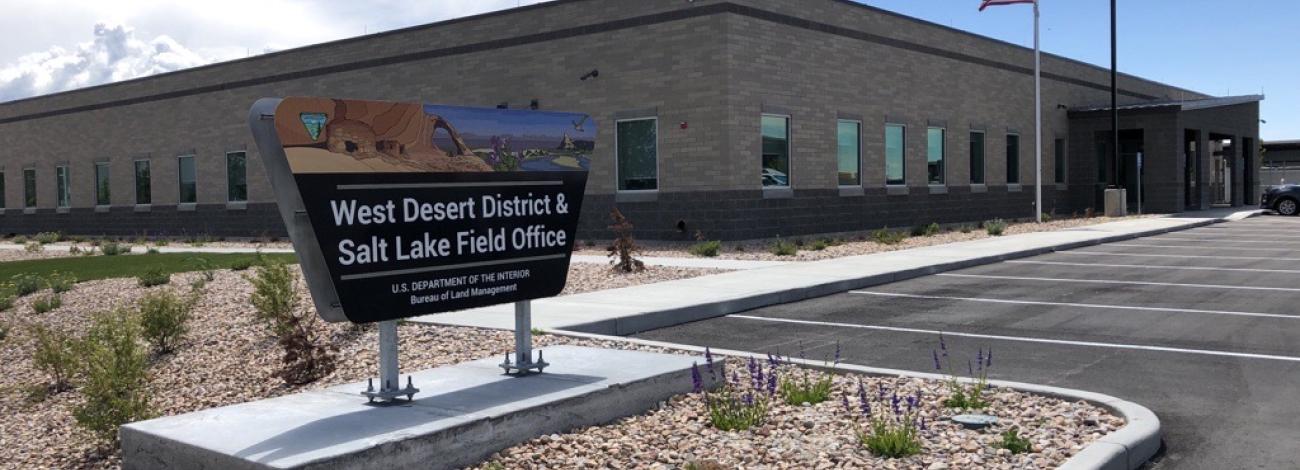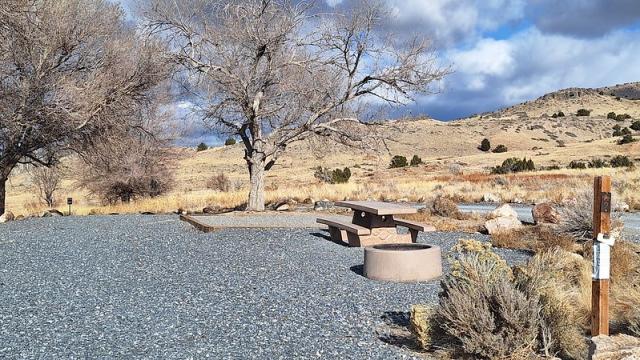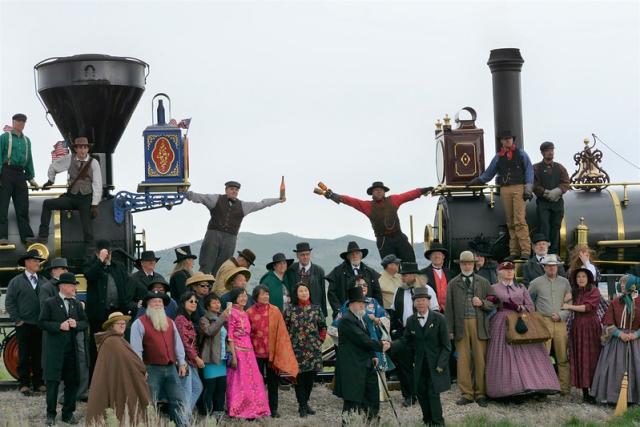
Salt Lake Field Office
The Salt Lake Field Office is located in the northwest corner of Utah and encompasses 3.3 million acres of public lands within eleven Utah counties. Much of this area is part of the Great Basin region, a place of isolated mountain ranges separated by desert playas and wide sweeping sagebrush flats. This area is also a land of illusions, floating islands and vanishing water mirages. Almost touching the Utah-Nevada border are the Bonneville Salt Flats, a unique expanse of pure, white salt crust. This geological oddity is world-renowned as the location of international landspeed racing. Just south of the Salt Flats lies the Pony Express Trail, where young riders risked their lives from 1860-61 delivering the mail from Missouri to California in only 10 days. To learn more about opportunities on your public lands, please contact or visit our office.
- Human History
-
Nestled in the northern third of the state the Salt Lake Field Office has within its boundary four of the prehistoric cultural physiographic regions: Columbia Plateau, Great Basin, Plains and Colorado Plateau. Over 12,000 years of prehistory has been recorded from prehistoric sites within the district, best exemplified by Danger Cave near Wendover. Lake Bonneville covered most of the area between 24,000-12,800 years ago. A smaller recession stand of the Lake Bonneville occurred between 10,000-9,000 years ago, known as the Gilbert shoreline. This lake stand covered a large portion of the west desert particularly the Newfoundland Basin and is associated with numerous late Paleo Indian habitation sites.
With the coming of Euro American settlement, predominately in the northern portions of the state, several unique historic period sites are located and managed by the Salt Lake Field Office. These include the Central Pacific Railroad, the Pony Express and the historic raceway at the Bonneville Salt Flats. Other interesting historic cultural sites outside the urban areas include the network of historic trails, such as the Butterfield Stage, the Hasting Cutoff (Donner-Reed party) and the California Trail.
Additionally, most of the Civil War to turn of the century historic mining took place within the Salt Lake Field Office boundaries. Important historic mining districts, such as the Tintic, Gold Hill and Ophir Districts are largely managed by the Salt Lake Field Office. WWII and early Cold War era military use left a significant imprint on the west desert. Historic sites such as the impact craters from the Enola Gay's test drops, the Gapa site (US army jet rocket tests similar to the German V1 rocket bomb) and numerous target and bombing ranges are located on BLM lands in the West Desert.
- Forests and Woodlands
-
Juniper-pinyon woodlands are the most common woodland or forest site found on BLM lands managed by the Salt Lake Field Office. These woodlands are dominated by small, usually scattered, conifers. In the Great Basin, which is a large portion of the Salt Lake Field Office, Utah juniper (Juniperus osteosperma) occurs either alone or together with single needle pinyon (Pinus monophylla). Stands of trees comprised only of Utah juniper are more often found on lower elevation, drier sites.
Juniper-pinyon woodlands, due to the mid-elevation position, often become thermal belts in semiarid precipitation zones. Average annual precipitation varies from 10 to 18 inches depending on the site. In some areas, trees have increased in density or have invaded adjacent areas typically dominated by other vegetation types. This increase in density and spread is due to a combination of factors, each of which has occurred simultaneously making it nearly impossible to determine if one causal factor is more important than the others. These woodlands have provided extensive areas for wildlife habitat, livestock grazing, recreation, and the harvest of wood products (fence posts, firewood, and Christmas trees). - Wildlife
-
The Wildlife Program of the Bureau of Land Management Salt Lake Field Office includes terrestrial and aquatic habitat management. An important component of the wildlife program is to evaluate potential affects to wildlife and associated habitat that may be impacted by proposed projects on BLM public lands. The BLM takes a holistic approach to balance ecosystem sustainability while meeting the multiple use mandate of the BLM.
BLM wildlife biologists achieve these goals by working closely with partners such the Utah Division of Wildlife Resources, U.S. Fish and Wildlife Service and non-governmental organizations on habitat restoration projects for the conservation of a variety of species. The BLM is also actively involved in applied research management with Utah State University and Brigham Young University. Notable projects in the Office include: the Utah Bat Database, Raptor Inventory Nest Survey, and Greater Sage-grouse monitoring. - Grazing
-
The Salt Lake Field Office authorizes livestock grazing and is committed to collecting monitoring data and developing grazing management systems to ensure that standards and guidelines for rangeland health are met. The office manages 303 allotments, which are held by 145 permittees. Permits and leases generally cover a 10-year period and are renewable if the BLM determines that the terms and conditions of the expiring permit or lease are being met. The amount of grazing that takes place each year on BLM-managed public lands can be affected by such factors as drought, wildfire, and market conditions.
- Lands and Realty
-
The Salt Lake Field Office provides and manages information related to landownership status, access and land records. Additionally, they process a variety of realty
actions including:Rights-of-way Grants: Authorizations issued for a variety of compatible uses of public land. Examples include roads, pipelines, communication sites, power lines, and telephone cables. It is recommended the applicant contact the Salt Lake Field Office and discuss a proposal before submitting an application in order to find out more about rights-of-way application procedures.
Land Use Permits: Issued for up to 3 years for temporary use of the land usually involving minor projects.
Film Permits: Special permits to use public land for commercial film productions including movies, television documentaries, videos, sound tracks, and advertisements. BLM Salt Lake Field Office public land has been the backdrop for numerous feature films, documentaries, TV show episodes, video and still photo ads. Past productions include World's Fastest Indian, Pirates of the Caribbean 3, Touched by An Angel, The Core, Independence Day, Con Air, Mulholland Falls, Buffalo Dreams, Boys of Bonneville and countless commercials.
Land Sales: The office currently has no lands available for sale. The preferred method of land disposal is by land exchange where a public benefit is obtained.Land Exchange: Exchanges with willing private land owners must have a substantial public benefit such as public access or critical wildlife habitat to be seriously considered. Anyone wishing to propose a land exchange must discuss their proposal with the lands staff before submitting a proposal in writing. Only those proposals with substantial public benefit will be considered.
Trespass: the unauthorized use of public land, and can result in financial penalties against persons found to be in trespass. Trespass activities include dumping of trash and debris, constructing/maintaining roads, farming/irrigation, and occupation without authorization. If you observe what you believe to be an unauthorized act or use, please contact the Salt Lake Field Office to have the activity investigated.
Withdrawals: Occasionally, BLM reserves or sets aside land from the operation of the public land laws, including location of mining claims, because development of the locatable mineral estate is not compatible with the purpose(s) for which the land is being used. Other withdrawals have been established for the benefit of other Federal agencies such as the Bureau of Reclamation for its water projects and the Department of Defense for military bases. - Minerals
-
Proximity to the population centers along the Wasatch Front puts the Salt Lake Field Office at the forefront of providing mineral materials for construction of roads, highways and commercial and residential development. Currently, the Salt Lake Field Office has active contracts for private extraction of sand and gravel and building stone and free use permits with entities of state and local government for sand and gravel deposits in Utah, Tooele, Box Elder, and Rich Counties. The Salt Lake Field Office also offers permits to private individuals to remove quantities of landscape rock and building stone in certain identified areas in the field office. Interested individuals should contact the office for information.
Leadership
Andrew Abbondanza
Emily Timer
Jordan Davis
Latest News
Contact
Salt Lake City, UT 84116
TTY/Relay System
If you are deaf, hard of hearing, or have a speech disability, please dial 7-1-1 to access telecommunications relay services.



